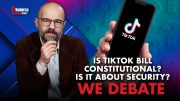
The address 33 Thomas Street in Lower Manhattan — less than a mile from the New York Stock Exchange — is a strange-looking structure. The dark gray skyscraper has 29 floors above ground and three basement levels. It has exactly zero windows and is not illuminated at night. The building — known as the “Long Lines Building” — is owned by AT&T. It is also code-named TITANPOINTE and is a major hub of NSA surveillance, with equipment and whole portions of the building dedicated to that purpose.
Project X, a new short film directed by Laura Poitras — who also directed the documentary Citizenfour, about Edward Snowden — and Henrik Moltke opens Friday at the IFC Center, just a mile and a half from the AT&T/NSA building. The film, produced by Field of Vision, exposes the incestuous relationship between AT&T and the NSA of which 33 Thomas Street is the perfect symbol: dark, secretive, and hidden in plain sight.
According to an in-depth joint reporting project between The Intercept and Field of Vision, the building that is now variously known as the “Long Lines Building” and TITANPOINTE began as “Project X” in 1969, and construction was completed in 1974. The building was designed to be “capable of withstanding an atomic blast” and would warehouse “enough food to last 1,500 people two weeks in the event of a catastrophe,” according to previously unpublished documents provided to The Intercept by Edward Snowden.
Because of the secrecy surrounding the building, many AT&T employees who worked there day in and day out for years had no idea that the person they rode the elevator with or passed in the hallway was an agent of the NSA who was there to spy on the communications of AT&T’s millions of customers. Of course, those AT&T employees who were in the dark also did not know that whole sections of the building housed the apparatus of the surveillance state. That equipment has changed over the years as technology has evolved. It now includes the most modern digital equipment and satellite receivers to monitor all forms of communication including mobile phones, Internet traffic, and VOIP (Voice Over Internet Protocol) communications such as Skype.
The designs for the super-secret building were created by John Carl Warnecke, who was one of the most renowned architects in the nation for the two decades between the 1960s and the 1980s. While — again because of the extreme secrecy surrounding TITANPOINTE — it has never been known how many people have worked at 33 Thomas Street at any given time, Warnecke’s original plans described the building as being capable of becoming a “self-contained city” with not only the aforementioned food and water for 1,500 people, but also recreation to keep them active and healthy and 250,000 gallons of fuel to power generators to keep the building running. While the 1,500 people may be taken care of, they are not the priority; they are merely the means to an end, like the fuel to power the building. The plans describe the building as “a skyscraper to be inhabited by machines” which was “designed to house long lines telephone equipment and to protect it and its operating personnel in the event of atomic attack.”
It’s a little like the old joke about the factory of the future containing only a machine, a man, and a dog. The machine does all of the manufacturing. The man’s job is to oil the machine and feed the dog. The dog’s job is to bite the man if he messes with the machine. At 33 Thomas Street, the people are necessary assets whose only value appears to be keeping the surveillance apparatus running, no matter what.
While the revelation of the existence of this building is important, it is small compared to the realization that AT&T (and presumably other major telecom companies) have been in bed with the NSA for much longer and to a much larger degree than the average American is probably aware. NSA documents refer to AT&T and other corporations as “partners.” These “partnerships” have been around for decades and have empowered the NSA to build the surveillance state that was greatly expanded after 9/11.
It also answers the cynicism of those who dismiss the idea of conspiracies by asking the question, “But is it possible for a conspiracy that large to go on that long without anyone talking about what they know?” The answer from 33 Thomas Street is a resounding “yes!” If Snowden had not leaked the trove of documents he did, this secret may well still have been being kept.
The report points out just how valuable a “partner” AT&T has been to the surveillance state, saying:
Historically, AT&T has always maintained close ties with the government. A good example of this came in June 1976, when a congressional subcommittee served AT&T with a subpoena demanding that it hand over information about its alleged role in unlawful FBI wiretapping of phone calls. President Gerald Ford personally intervened to block the subpoena, stating that AT&T “was and is an agent of the United States acting under contract with the Executive Branch.”
Let’s just unpack that for a minute. AT&T — a private corporation providing a service to millions of private citizens — “is an agent of the United States acting under contract with the Executive Branch.” With that being the case, what, exactly, are those millions of private citizens who pay AT&T for providing that service? The reasonable answer would be — in the parlance of the agents who conduct the surveillance — targets.
This new revelation also underscores the size and scope of the surveillance state, which is the illegitimate offspring of the incestuous relationship between government and corporations. Unaccountable government agencies that wish to spy on any and all would be unable to do so without the assistance of corporations that provide the infrastructure and the technical support. To make matters worse, many devices and softwares are designed to spy on users. The culture of surveillance feeds from the twin troughs of overreaching government agencies and irresponsible corporations. As this writer wrote in a previous article:
There is no liberty without privacy. As the culture of surveillance grows, liberty recedes. The New American has reported on many of the threats to privacy that are becoming more and more commonplace. Some Smart TVs are spying on users via their integrated cameras, microphones, and Internet connectivity and then reporting back to the manufacturers, who sell that data to advertisers. Other “Internet of Things” devices have surveillance capabilities that are marketed as features promising convenience to users. Facebook performs social/psychological experiments on its users and also harvests users’ data to sell to advertisers.
To make matters worse, Microsoft has turned its operating system, Windows, into a suite of softwares designed to spy on users, report back to Microsoft on their use, and remotely remove software from their computers, all while hiding these activities from all but the most tech-savvy users.
Since any chain is only as strong as its weakest link, the culture of surveillance — upon which rests the surveillance state — fosters an environment in which a plethora of weak links are manufactured, marketed, and sold to an unsuspecting public who then provide the very means by which they are spied upon.
After the Snowden revelations, there were promises to “reform” NSA and other agencies conducting mass surveillance. In the wake of that supposed “reform,” the surveillance hawks began claiming that the scales had been tipped too far and that in the vacuum of information that had been created, terrorist attacks — such as the ones on Paris last year — were able to be planned and executed without forewarning. Nothing could be further from the truth. The report by The Intercept and Field of Vision points out that in the wake of surveillance scandals in the mid 1970s, Congress sought to “reform” the surveillance agencies by passing, in 1978, “the Foreign Intelligence Surveillance Act [(FISA)], requiring the executive branch to request warrants for spying operations from a newly formed court.” Of course, we know now that the FISA court almost always approved such requests. There was a new law, but no reform took place. If it had, Snowden wouldn’t have had all those documents about mass surveillance to leak.
When the new “reforms” were put in place in the wake of the Snowden revelations, Congress passed the USA FREEDOM Act, which was supposed to curtail all of that surveillance and protect the freedom (thus the name) of American citizens. But, as this writer wrote in a previous article:
The USA FREEDOM Act, like the USA PATRIOT Act of 2001, is a misnomer. The name is a not-very-subtle manipulation, designed to hide from the American people the real nature of the law. The architects of the USA PATRIOT Act used the word “patriot” to persuade Americans that the “patriotic” way to confront the specter of terrorism was to trade liberty for security. It took the one but never delivered the other. Likewise, in the USA FREEDOM Act, the use of the word “freedom” is designed to convince Americans that their freedom is being returned to them by “reforming” the surveillance state. In fact, no such reform is taking place.
And:
When the final USA FREEDOM Act vote was counted in the Senate on June 2, 2015, The New American‘s Warren Mass reported that the act, which was sold to the American people as a way to “reform the authorities of the Federal Government” to (among other things) conduct electronic surveillance for “foreign intelligence, counterterrorism, and criminal purposes,” was both misleading and unnecessary. If true reform had been the goal, a large part of that goal had already been accomplished. On May 31 the provisions of the USA PATRIOT Act, which had been interpreted to allow much of the surveillance exposed by Snowden, expired:
Many of those authorities — which the National Security Agency (NSA) has used to justify the collection of phone records — had been found in provisions of the USA PATRIOT Act that expired at midnight Sunday night. Therefore, Congress could have eliminated those surveillance powers merely by doing nothing.
Despite promises made by its supporters, the USA Freedom Act doesn’t end government snooping. It merely shifts the responsibility for collecting communications metadata from the NSA to companies such as AT&T, Sprint, and Verizon, which already keep customer records for as long as five years. The NSA or the FBI would simply need to obtain permission from the secret FISA Court to access that data — and the court nearly always grants it.
So, rather than limiting government powers — which had already been done by the sun setting on parts of the USA PATRIOT Act — what the USA FREEDOM Act really does is make the mobile telecom companies arms of the federal government in keeping the surveillance state running along smoothly.
Considering that the report states that the NSA has “strategic partnerships” with more than 80 corporations and operates multiple facilities such as the one at 33 Thomas Street where employees — many unaware — assist in the surveillance of American citizens, there is really no change at all in putting the responsibility of the surveillance on the major telecom companies. They’ve been doing the grunt work and heavy lifting all along.
Since modern life almost requires some degree of using modern technology, the surveillance state takes advantage of that technology to vacuum up all of the data on all of the people. Fortunately, technology is an equal opportunity tool and can also be used to protect the privacy and liberty of its users. Because it’s obvious by now that government “reforms” aren’t going to.




